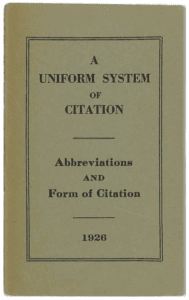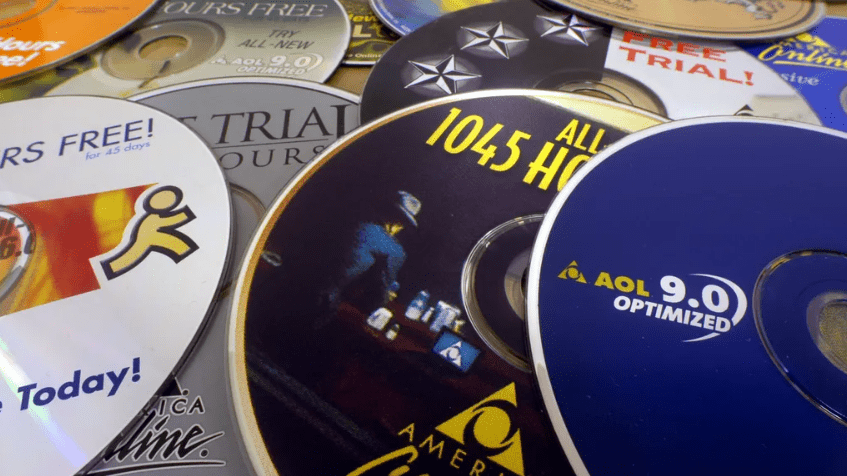Legal practice has historically lagged media innovation
The first edition of what we know as The Bluebook: A Uniform System of Citation was published in 1926 and was just 26 pages long.1 Before The Bluebook, attorneys relied on locally developed citation practices, court-specific style customs, and early law review conventions.
Exactly how the modern Bluebook came to be is still the subject of some debate among Ivy League law schools (for a deep dive, read The Secret History of the Bluebook by Fred R. Shapiro and Julie Graves Krishnaswami), but it aimed to standardize citation formats across journals and practitioners.
Over the years, The Bluebook has been edited and updated to better reflect modern legal practice—the 22nd edition was just published in May 2025—but it hasn’t always quite kept pace with the evolution of modern media.

Citing television broadcasts in legal writing
Like The Bluebook, television was also created in the late 1920s. It started to gain traction after World War II, and by 1960, 90% of US households had a TV.2 However, it wasn’t until 1986 and the 14th edition of The Bluebook that attorneys were finally provided explicit guidance on how to cite television programs in a legal brief.

Rule 15.5.3 (renumbered over time), first introduced citation formats for audiovisual media. The 22nd edition of The Bluebook now includes Rule 18.6 Films, Broadcasts, and Noncommercial Video Materials, which prescribes the following format:
Pursuant to Bluebook Rules 18.7 and 18.8, cite films (Rule 18.7.1) by presenting the film title in small capitals, followed by the access medium and a parenthetical indicating the production company and year. For television series (Rule 18.7.2), cite the series title in small capitals and the episode title in italics, followed by the access medium in a parenthetical including the release or broadcast date. For radio broadcasts (Rule 18.8.1(c)), cite the episode title in italics, followed by the broadcast platform and date in a parenthetical. When known, include the name of the production company or broadcasting entity; if that is unavailable, include the name of the network or platform that aired or distributed the content.
Example of how to cite a TV broadcast in a legal brief:

Citing online sources in legal writing
The Bluebook provided guidance only slightly faster when it came to citing web pages.
If you’re of a certain age, you’ll remember being inundated with AOL floppy discs and CDs in the mail (that’s snail mail), which propelled the adoption of the Internet in the late 1990s and early 2000s. It’s estimated that AOL mailed more than 1 billion such CDs from 1993-2006.3
If you’re too young to remember, here’s a visual, courtesy of Smithsonian Magazine:

While earlier editions of The Bluebook treated online materials as a subcategory of print or didn’t provide formalized rules, the 20th edition, published in 2015, recognized the increasing importance of online sources with Rule 18 Electronic Media and Other Nonprint Resources, which provided guidance on how to cite websites, online PDFs, and other internet-based materials.
Flash forward 10 years to today and digital sources—podcasts, social posts, and short videos—are now central to modern legal practice. Accordingly, The Bluebook 22nd Edition (see Rules 18.8 & 18.10) spells out how to cite them, no matter the platform.
How to cite podcasts in a legal brief
Serial radio programs were still all the rage when the first several editions of The Bluebook were published. Today, podcasts have emerged as a popular way to consume episodic content. According to Nielsen, podcasts represent 15% of daily audio time for people ages 35+ and 32% of daily audio time among those 18-34.4
Here’s what you need to know to properly cite a podcast:
Relevant Rule(s): Bluebook 22, Rules 18.8.1(c): Episodic recordings on a streaming service (e.g., Spotify)
Format for citing a podcast:

Example of how to cite a podcast in legal writing:

URLs & archives—optional, not required
Bluebook’s model (Strict Scrutiny example) omits a URL. You may add a direct link plus a Perma.cc archive or “(on file with author)” if firm policy or local rules require, for example:

How to cite posts on X (aka Tweets) in legal writing
Twitter launched as a public microblogging platform in July 2006 and quickly became a social media juggernaut. Elon Musk famously acquired it for $44B in 2022 and rebranded it as X. X still has over 500 million monthly active users,5 generating a huge volume of ephemeral content, which may need to be cited.
Here’s what you need to know to cite a Tweet correctly:
Relevant Rule: Bluebook 22, Rule 18.10.1(b): Textual content
Format for citing a Tweet:
Author’s Name (@handle), X (Date, at Time), URL [https://perma.cc/…].
- Handles: use the exact platform format (e.g., “@JaneDoe”)
- Date & time: include as much detail as is visible (time zone optional but recommended)
- Permanent location: archive link is preferred ([https://perma.cc/…]); otherwise use (on file with author)
Example of how to cite a Tweet in legal writing:
TypeLaw (@TypeLaw), X (June 2, 2025, at 10:17 AM PST), https://x.com/TypeLaw/status/1929588168212328737.
Note that Rule 18.10.1(b): Textual content also applies to other text-based social media posts, such as Facebook or LinkedIn posts.
How to cite TikToks, Instagram Reels, and other short videos in legal writing
Creating a podcast is a real time commitment, but anyone can take a few seconds to click and show off their dance moves. The simplicity of posting short video content is making TikTok and Instagram incredibly popular for both professional and amateur content creators—and increasingly common to cite in legal briefs.

Here’s what you need to know to cite short videos correctly:
Relevant Rule: Bluebook 22, Rule 18.10.1(a): Visual & audio content
Format for citing TikToks, Instagram Reels, and other short videos:
Video posted by Poster Name (@handle), TikTok, Title/Caption (Date), URL (permanent location).
- Type of content: start with “Video posted by …”
- Title or caption: include if it helps identify relevance
- Permanent location: If Perma.cc fails for TikTok, cite (on file with …)
Note that longer-form YouTube videos fall under Rule 18.7.4 – Web-Based Videos.
Example of how to cite a TikTok or IG Reel in a legal brief:
Video posted by Kim Kardashian (@kimkardashian), TikTok, Passing the Baby Bar (Apr. 24, 2023, 17:00 PST), https://www.tiktok.com/discover/kim-kardashian-passing-baby-bar (on file with author).
Cite digital evidence with confidence
It’s challenging for even the most meticulous, experienced legal professionals to keep up with court rules around the rapidly evolving social media landscape.
Here are some final guidelines to keep in mind:
- Always archive: Rule 18.2.1(d) now requires archiving for all internet sources
- Parentheticals matter: If the URL cannot be archived, use “(PDF on file with author)” after the citation
- Timestamps are key: For podcasts or videos, cite the relevant moment, e.g., “at 02:03”
Digital evidence is here to stay—and so are the formatting risks. TypeLaw’s automated brief formatting service is prepared to handle the new Bluebook 22 steps for podcasts, Tweets, and videos, helping you save time and cite confidently, no matter how formerly “uncitable” the source.
Want to see TypeLaw in action? Contact us to schedule a demo.
- The Secret History of the Bluebook, Fred R. Shapiro and Julie Graves Krishnaswami, Minnesota Law Review, April 9, 2016. ↩︎
- American Women: Resources from the Moving Image Collections, Library of Congress Research Guides. ↩︎
- In memoriam: AOL CDs, history’s greatest junk mail, Phil Edwards, Vox, May 12, 2015. ↩︎
- The Record: Q1 U.S. audio listening trends, Nielsen, May 2025. ↩︎
- Most popular social networks worldwide as of February 2025, by number of monthly active users, Statista, March 26, 2025. ↩︎


